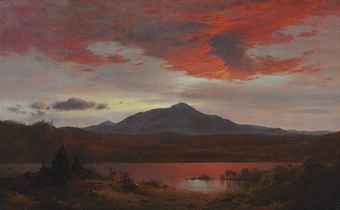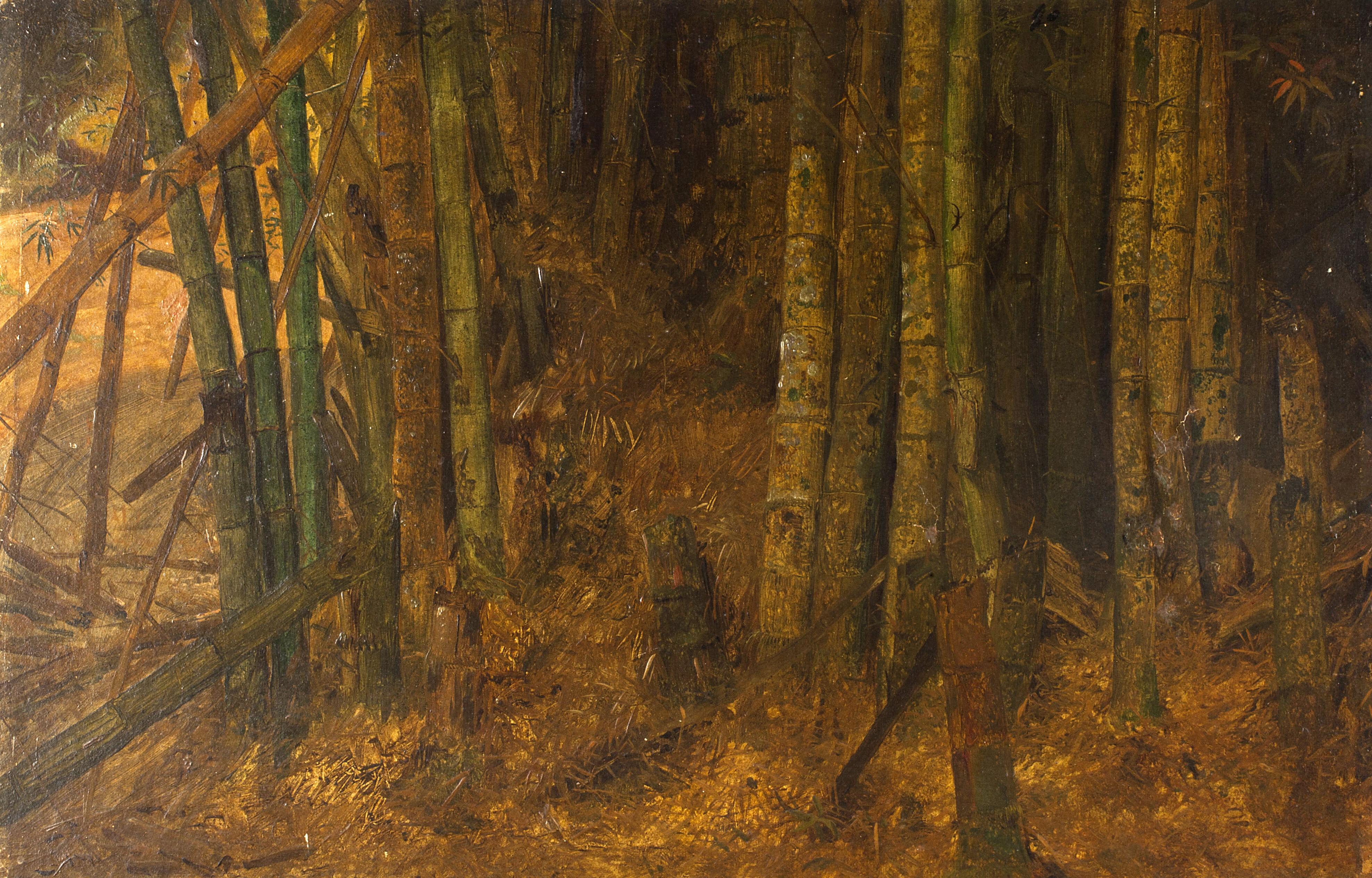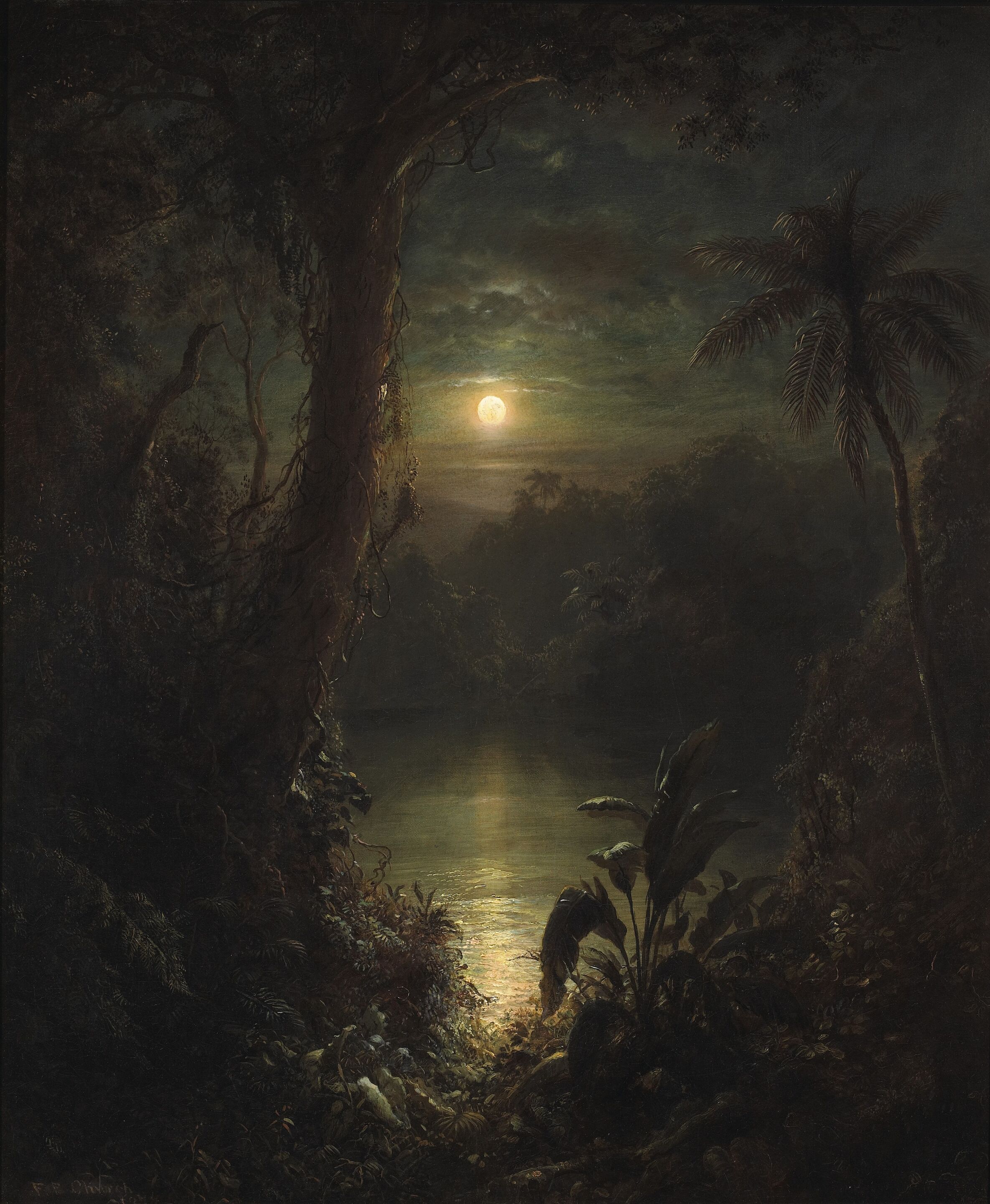Biography
Frederic Edwin Church
was born in Hartford, Connecticut, on May 4, 1826, the only son of a
wealthy businessman. Although his father hoped he would become a
physician or enter the world of business, Church persisted in his early
desire to be a painter. In 1842-1843 he studied in Hartford with
Alexander H. Emmons (1816-1879), a local landscape and portrait painter,
and Benjamin H. Coe (1799-after 1883), a well-known drawing instructor.
In 1844 Church's father, at last resigned to his son's choice of a
career, arranged through his friend, the art patron Daniel Wadsworth,
two years of study with Thomas Cole. Church was thus the first pupil
accepted by America's leading landscape painter, a distinction that
immediately gave him an advantage over other aspiring painters of his
generation. From the first, Church showed a remarkable talent for
drawing and a strong inclination to paint in a crisp, tightly focused
style. In 1845 he made his debut at the annual exhibition of the
National Academy of Design in New York, where he would continue to show
throughout his career. Two years later four of his paintings were shown
at the American Art-Union, and by that point he was established in New
York as one of the most promising younger painters. In 1849, at the age
of twenty-three, he was elected to full membership in the National
Academy, the youngest person ever so honored.
During the late 1840s and early 1850s Church experimented with a variety of subjects, ranging from recognizable views of American scenery, to highly charged scenes of natural drama, to imaginary creations based on biblical and literary sources and much indebted to Cole. Gradually, however, he began to specialize in ambitious works that combined carefully studied details from nature in idealized compositions that had a grandeur and seriousness beyond the usual efforts of his contemporaries. Church traveled widely in search of subjects, first throughout the northern United States and then, in 1853, to South America. Inspired by the writings of the great German naturalist Alexander von Humboldt, he spent five months in Colombia and Ecuador.
His first full-scale masterpiece,
The Andes of Ecuador (1855; Reynolda House Museum of American Art, Winston-Salem),
was a four-by-six-foot canvas depicting a vast tropical mountain panorama that astounded viewers with its combination of precise foreground detail and sweeping space.
Two years later Church's reputation as America's most prominent landscape painter was secured with the exhibition in New York, London and other cities of
Niagara (1857; Corcoran Gallery of Art, Washington) in New York.
A second trip to South America took place that same year and resulted two years later in his most famous painting of the tropics,
Heart of the Andes (1859; The Metropolitan Museum of Art, New York).
During the late 1840s and early 1850s Church experimented with a variety of subjects, ranging from recognizable views of American scenery, to highly charged scenes of natural drama, to imaginary creations based on biblical and literary sources and much indebted to Cole. Gradually, however, he began to specialize in ambitious works that combined carefully studied details from nature in idealized compositions that had a grandeur and seriousness beyond the usual efforts of his contemporaries. Church traveled widely in search of subjects, first throughout the northern United States and then, in 1853, to South America. Inspired by the writings of the great German naturalist Alexander von Humboldt, he spent five months in Colombia and Ecuador.
His first full-scale masterpiece,
The Andes of Ecuador (1855; Reynolda House Museum of American Art, Winston-Salem),
was a four-by-six-foot canvas depicting a vast tropical mountain panorama that astounded viewers with its combination of precise foreground detail and sweeping space.
Two years later Church's reputation as America's most prominent landscape painter was secured with the exhibition in New York, London and other cities of
Niagara (1857; Corcoran Gallery of Art, Washington) in New York.
A second trip to South America took place that same year and resulted two years later in his most famous painting of the tropics,
Heart of the Andes (1859; The Metropolitan Museum of Art, New York).
Christie’s NOVEMBER 30, 2011
FREDERIC EDWIN CHURCH (1826-1900)
Twilight
Estimate: $1,000,000 – 1,500,000
Possibly no other American so faithfully
captured the higher, more elusive meanings of landscape as Frederic Edwin
Church, whose unmatched ability to record natural details captivated the
public, and earned him a reputation for technical brilliance even as a young
man. Painted at the height of his career, in 1863, Twilight (pictured
above; estimate $1,000,000-1,500,000) is a masterwork in which Church captures
the majesty and promise inherent in the national landscape, the subject for
which he is most renowned. In this scene of a glowing red sunset reflected on
Maine’s highest peak, Mount Katahdin, he simultaneously presents a powerful and
grand scene of nature and a picture of quiet solitude, creating a deeply
profound work that is a superb representation of the artistic, political and
social influences of his day. The importance of Twilight in Church’s
oeuvre is underscored by its provenance, having belonged to William Henry
Osborn, who was one of Church’s great patrons and also a close friend. Osborn
was the son-in-law of famed collector and patron, Jonathan Sturges, who
commissioned some of the most celebrated works of Thomas Cole, Asher B. Durand
and others.
Bonhams December 4, 2013
FREDERIC EDWIN CHURCH
(American, 1826-1900)
A study of bamboo 11 3/4 x 17 7/8in
Estimate 800,000 — 1,200,000
Lot Sold 905,000
Christie's 1999
Bonhams May 20, 2009
Frederic Edwin Church (American, 1826-1900)
Twilight in the Tropics (A tropical moonlight)
30 x 25 1/4in
Christie's 1999
Bonhams May 20, 2009
Frederic Edwin Church (American, 1826-1900)
Twilight in the Tropics (A tropical moonlight)
30 x 25 1/4in
Sold for US$ 1,274,000
National Gallery of Art, Washington, DC
National Gallery of Art, Washington, DC
-
- Church, Frederic Edwin
- , American, 1826 - 1900
- Tamaca Palms
- 1854
- oil on canvas
- overall: 67.9 × 91.3 cm (26 3/4 × 35 15/16 in.)
- framed: 103.5 × 127.6 × 14.6 cm (40 3/4 × 50 1/4 × 5 3/4 in.)
- Corcoran Collection (Gift of William Wilson Corcoran)
- 2014.79.11
-
- Church, Frederic Edwin
- , American, 1826 - 1900
- El Rio de Luz (The River of Light)
- 1877
- oil on canvas
- overall: 138.1 x 213.7 cm (54 3/8 x 84 1/8 in.)
- framed: 160.7 x 237.5 x 7.6 cm (63 1/4 x 93 1/2 x 3 in.)
- Gift of the Avalon Foundation
- 1965.14.1









_Frederic_Edwin_Church.jpg)